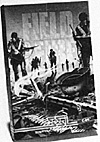
Designed by Roger Damon
Strategic Simulations Inc.
883 Stierlin Rd., Building A-200,
Mountainview, CA 94043
Price:$39.95
Complexity: Medium
Solitaire Suitability: Excellent
Field of Fire is a solitaire computer simulation of tactical ground combat on the Western Front in WWII. It is available for the Atari and Commodore computers. This review is based on my experience with the Atari version.
I really like this game. It is easy to play and challenging to win. Although not perfect, I think that it is well worth its price.
The game has eight separate scenarios, arranged chronologically from the early war fighting in Africa to a river crossing in Germany at the end of the war. Each of the scenarios is quite different, both in terrain and in the problems that must be solved to win. You must raid, attack, defend, and pursue. It is possible to play a single scenario or play a role-playing campaign (all eight scenarios in sequence) in which you try to develop your green troops into reliable veterans.
The scale of the game is tactical, with each unit representing a fire team or single tank. Each fire team is represented by a symbol showing its basic weapon type. The rifle team is the most numerous unit, but also available are machine guns, mortars, bazookas, engineers, tanks, anti-tank guns, and the American HQ (headquarters, which is you).
Units are further identified by the name of their leader. Each leader has certain characteristics that are reflected in the abilities of his squad. The game does not display the numeric values for these characteristics, and you must decide what they are by the performance of t e squad. If you play a standard scenario, you get the standard set of leaders. The rule book gives a thumbnail sketch of each of these. If you play the role-playing version of the game, the characteristics of your troops are developed as you go through the eight scenarios, and you watch how your troops perform to figure out who your dependable leaders are. This is a realistic touch, but I would have liked the option of seeing a listing of how my units were doing and what characteristics were being considered.
Play in Field of Fife is divided into several phases, the length of which are generally under player control. The first phase is the largely superfluous Observation Phase, in which no orders can be entered, but you are allowed to scroll around the map. After the Observation Phase, you enter fire and movement orders for all of your units. This is done by using the joystick to select the unit, and then selecting its target or destination. This process is extremely easy to do and is one of the strengths of the game. After the orders have been entered, you enter the Operations Phase and execute those orders. As play progresses, your units will fire at their targets and attempt to move to their objectives. You can interrupt the Operations Phase either to change orders or enter Assault Orders, which allow your troops to move onto and (hopefully) destroy adjacent enemy units. Periodically, the enemy units get to move and you are told how you are doing relative to your victory conditions. These "victory" phases are indicative of the completion of a "cycle. " According to the rule book, most games are complete after about 14 cycles, but I rarely found myself keeping track.
The game flows very well. Even though the movement is done sequentially (first you move and then the enemy moves), the fortunate combination of the easy order giving process and the constant action gives the effect of being "real-time."
My only real objection to the play of this game is that units shoot at positions, rather than targets, and do not react in any way to enemy movement or a changing situation. For example, if you direct covering fire at a woods line, and an enemy unit appears adjacent to the position you are shooting at, you must redo the firing orders to attack the unit. Similarly, if you are shooting at a unit, and it moves, you do not retain it as a target. It is not hard to change fire orders, but it does slow things down and seems a bit unrealistic. I think that the game would be improved if the individual units had some ability to react on their own.
The bad guys always start hidden and are revealed when they fire, move or when your suppressive fire takes effect. Although it is sometimes possible to rush forward, it is best to use sound tactics by establishing 2 fire base to suppress possible and Known enemy positions as this reduces their counter- fire. If this is not done, it is easy to get your units badly chewed up. You must constantly monitor the situation, to quickly bring down fire on newly revealed enemy units. If you just let the operations phase proceed, you are likely to get ambushed. Sound tactics will allow you to both survive and win.
Field of Fire is an excellent game. The scenarios are challenging and give considerable variation in goals and objectives. Orders are easy to enter and understand. If you like tactical level computer games, you should be pleased by this one.
More War Game Reviews
-
Game Review: Decision in the Desert
Game Review: Field of Fire
Game Review: 4th Reich Puremen vs. The Mutants for Control of the World
Game Review: Russian Front
Game Review: La Bataille D'Auerstaedt
Back to Table of Contents -- Game News #12
To Game News List of Issues
To MagWeb Master Magazine List
© Copyright 1986 by Dana Lombardy.
This article appears in MagWeb (Magazine Web) on the Internet World Wide Web.
Other military history articles and gaming articles are available at http://www.magweb.com